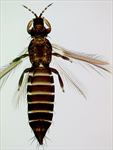
Female
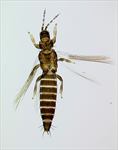
Male
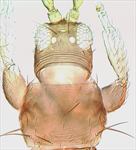
Head & pronotum

Male & female antennae
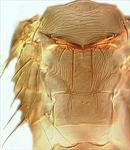
Meso & metanotum

Tergites VII–X

Sternites VI–VII
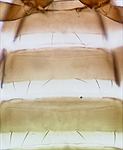
Female sternites II–IV
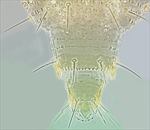
Larva abdomen

Male sternites
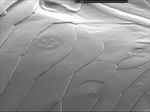
Male sternal pore plates (SEM)
Female macropterous; body colour dark brown, tarsi yellow, antennal segments III & IV with apical neck sharply white or yellow; fore wings brown but slightly paler at base. Antennae 8-segmented, VIII longer than VII; III with 2 stout, dark, dorsal setae; III & IV each with constricted apical neck and forked sense cone. Head as wide as long, 3 pairs of ocellar setae present, pair III just inside anterior margins of ocellar triangle and longer than distance between compound eyes; postocular setae IV as long as distance between hind ocelli. Pronotum with 2 pairs of long posteroangular setae, posterior margin with 5 pairs of setae of which the submedian pair is more than twice as long as the discal setae. Metanotum reticulate medially, campaniform sensilla present, median setae arise at anterior margin. Mesofurca with spinula. Fore wing first vein with 2 setae on distal half, second vein with complete row of setae. Tergites without sculpture between median setae, and without ctenidia; tergite VIII posteromarginal comb represented by a 10–20 fine microtrichia laterally but with a wide gap medially. Sternites without discal setae, median pair of marginal setae on sternite VII arise anterior to margin, setae S2 closer to median setae than to setae S3.
Male similar to female but smaller and more slender, antennal segment VI unusually long; tergite IX with pair of small spine-like processes on posterior margin; sternites III–VII each with more than 25 small circular pore plates.
Second instar larva white with posterior margin of tergites IX & X light grey; tergite IX posterior margin with about 10 tubercles and 3 large tubercles laterally; sternite IX posterior margin with many small teeth.
The relationships of P. kellyanus remain in doubt. One of nine species currently listed in Pezothrips, they are all, apart from P. kellyanus, restricted to eastern and central Europe. This species was placed in Taeniothrips at one time, but has a pair of setae on the head in front of the first ocellus. It shares some character states with the legume-flower thrips in Megalurothrips in which genus it was also placed for many years. Nguyen et al. (2015) recognised that kellyanus originated in Australia, despite the current generic position.
In Australia, breeding in a range of highly scented white flowers, including Citrus, Jasminum, Hymenosporum and Pittosporum species. The original host plant is probably Hymenosporum flavum, a small tree in the forests of northeastern Australia and New Guinea. Larvae and adults feed on flowers, and young leaves and fruit, pupating at ground level. Males form aggregations to which females are attracted for mating (Webster et al., 2006). Feeding by larvae on young citrus fruits leads to unsightly circum-polar scarring as these fruits expand, particularly in temperate areas of Australia, also New Zealand and several Mediterranean countries.
Originally from Australia, now found in New Zealand, New Caledonia, southern France, Italy, Greece, Cyprus, and Turkey. Not recorded from North America although likely to be taken in quarantine because it occurs in Hawaii (Mound et al., 2016).
THRIPIDAE - THRIPINAE
Pezothrips kellyanus (Bagnall)
Physothrips kellyanus Bagnall, 1916: 219
Physothrips livii Girault, 1930: 2
Taeniothrips kellyanus (Bagnall); Mound, 1968: 58
Megalurothrips kellyanus (Bagnall); Bhatti, 1969: 241
Pezothrips kellyanus (Bagnall); zur Strassen, 1996: 113.
Mound LA, Nakahara S & Tsuda DM (2016) Thysanoptera-Terebrantia of the Hawaiian Islands: an identification manual. ZooKeys 549: 71–126.
Nguyen DT, Spooner-Hart RN & Riegler M (2016) Loss of Wolbachia but not Cardinium in the invasive range of the Australian thrips species, Pezothrips kellyanus. Biological Invasions 18: 197–214.
Webster KW, Cooper P & Mound LA (2006) Studies on Kelly’s Citrus Thrips (Pezothrips kellyanus Bagnall): sex attractants, host associations and country of origin. Australian Journal of Entomology 45: 67–74.